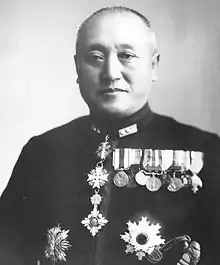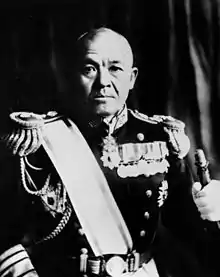Eastern Solomons order of battle
The Battle of the Eastern Solomons was fought August 23–25, 1942 in the waters east and northeast of the Solomon Islands by forces of the Imperial Japanese Navy's Combined Fleet and the US Navy's Pacific Fleet. The battle resulted from a major effort by the Japanese to reinforce their troop strength on the island of Guadalcanal. The Japanese high command had realized this reinforcement was necessary following the annihilation of the Ichiki Detachment by the 1st Marines a few days earlier.


The battle can be counted both a tactical and strategic American victory: greater ship losses were inflicted on the Japanese, and the transports were turned back from their mission of landing reinforcements.
Forces deployed
- Combat ships: 2 fleet carriers, 1 light carrier, 3 old battleships, 12 heavy cruisers, 3 light cruisers, 30 destroyers, 2 1st-class submarines, 1 2nd-class submarine
- Aircraft: 69 fighters, 41 dive bombers, 57 torpedo bombers
![]() American forces:
American forces:
- Combat ships: 3 fleet carriers, 1 fast battleship, 5 heavy cruisers, 2 anti-aircraft light cruisers, 18 destroyers
- Aircraft: 100 fighters, 54 dive bombers, 54 scout bombers, 45 torpedo bombers
Ship losses
IJN: 1 light carrier, 1 destroyer, 1 1st-class submarine
USN: none
Japanese order of battle
Guadalcanal Supporting Forces







Vice Admiral Nobutake Kondo[1]
Advanced Force
Vice Admiral Nobutake Kondo
Main Body
- Cruiser Division 4
- Cruiser Division 5 (Vice Adm. Takeo Takagi)
- Screen
Support Group
Striking Force
Vice Admiral Chuichi Nagumo
Carrier Group (Vice Admiral Nagumo)
- 2 fleet carriers
- Shōkaku (Capt. Masafumi Arima, Nagumo's flagship):
- 27 Mitsubishi A6M "Zeke" fighters (Lt. Hideki Shingo)
- 27 Aichi D3A "Val" dive bombers (Lt. Cdr. Mamoru Seki)
- 18 Nakajima B5N "Kate" torpedo bombers (Lt. Cdr. Shigeharu Murata)
- Zuikaku (Capt. Tameteru Notomo):
- 27 Mitsubishi A6M "Zeke" fighters (Lt. Ayao Shirane)
- 27 Aichi D3A "Val" dive bombers (Lt. Sadamu Takahashi)
- 18 Nakajima B5N "Kate" torpedo bombers (Lt. Shigeichiro Imajuku)
- Shōkaku (Capt. Masafumi Arima, Nagumo's flagship):
- Screen
Vanguard Group (Rear Admiral Hiroaki Abe)
- 2 old battleships: Hiei (Abe's flagship), Kirishima
- Cruiser Division 7 (Rear Admiral Shoji Nishimura)
- Destroyer Squadron 10 (Rear Admiral Susumu Kimura)
Diversionary Group (Rear Admiral Chūichi Hara)
- 1 light carrier: Ryujo (Capt. Tadao Kato) (sunk):
- 24 Mitsubishi A6M "Zeke" fighters (Lt. Kenjiro Notomi)
- 9 Nakajima B5N "Kate" torpedo bombers (Lt. Binichi Murakami)
- 1 heavy cruiser: Tone (Hara's flagship)
- 2 destroyers: Amatsukaze, Tokitsukaze
Southeast Area Forces




Vice Admiral Nishizo Tsukahara
Outer South Seas Force
Vice Admiral Gunichi Mikawa
Reinforcement Group (Rear Admiral Raizo Tanaka)
- Transport Unit
- 1 auxiliary cruiser: Kinryu Maru
- Embarking 800 men of the 5th Yokosuka SNLF
- 4 patrol boats: #1, #2, #34, #35
- Embarking 700 men of the 2nd echelon of the IJA Ichiki Detachment
- 1 auxiliary cruiser: Kinryu Maru
- Escort Unit
Covering Group (Vice Admiral Mikawa)
- Cruiser Division 6 (Rear Adm. Aritomo Goto)
Submarine Group
- 2 1st-class submarines
- I-121, I-123 (sunk)
- 1 2nd-class submarine
- Ro-34
American order of battle
Task Force 61





Vice Admiral Frank Jack Fletcher in Saratoga[2]
Task Force 11
Vice Admiral Fletcher
1 fleet carrier:
- Saratoga (Capt. DeWitt C. Ramsey)
- Saratoga Air Group (Cmdr. Harry D. Felt)
- 27 F4F Wildcat fighters (VF-5 – Lt. Cmdr. Leroy C. Simpler)
- 17 SBD Dauntless dive bombers (VB-3 – Lt. Cmdr. Dewitt W. Shumway)
- 15 SBD Dauntless scout bombers (VS-3 – Lt. Cmdr. Louis J. Kirn)
- 13 TBF Avenger torpedo bombers (VT-8 – Lt. Harold H. Larsen)
- Saratoga Air Group (Cmdr. Harry D. Felt)
Cruisers (Rear Admiral Carleton H. Wright):
- 2 heavy cruisers: Minneapolis (Capt. Frank J. Lowry), New Orleans (Capt. Walter S. DeLany)
Screen (Capt. Samuel B. Brewer):
- 5 destroyers
- 1 Porter class (8 x 5-in. main battery): Phelps
- 4 Farragut class (4 x 5-in. main battery): Farragut, MacDonough, Worden, Dale
Task Force 16
Rear Admiral Thomas C. Kinkaid in Enterprise
1 fleet carrier:
- Enterprise (Capt. Arthur C. Davis)
- Enterprise Air Group (Lt. Cmdr. Maxwell F. Leslie)
- 29 F4F Wildcat fighters (VF-6 – Lt. Louis H. Bauer)
- 17 SBD Dauntless dive bombers (VB-6 – Lt. Ray Davis)
- 18 SBD Dauntless scout bombers (VS-5 – Lt. Turner F. Caldwell)
- 15 TBF Avenger torpedo bombers (VT-8 – Lt. Cmdr. Charles M. Jett)
- Enterprise Air Group (Lt. Cmdr. Maxwell F. Leslie)
Battleship and Cruisers (Rear Admiral Mahlon S. Tisdale):
- 1 fast battleship: North Carolina (Capt. George H. Fort)
- 1 heavy cruiser: Portland (Capt. Laurance T. DuBose)
- 1 anti-aircraft light cruiser:[lower-alpha 1] Atlanta (Capt. Samuel P. Jenkins)
Screen (Capt. Edward P. Sauer):
- 6 destroyers
- 1 Porter class (8 x 5-in. main battery): Balch
- 2 Gleaves class (5 x 5-in. main battery): Grayson, Monssen
- 1 Gridley class (4 x 5-in. main battery): Maury
- 2 Benham class (4 x 5-in. main battery): Benham, Ellet
Task Force 18
Rear Admiral Leigh Noyes in Wasp
1 fleet carrier:
- Wasp (Capt. Forrest P. Sherman)
- Wasp Air Group (Lt. Cmdr. Wallace M. Beakley)
- 28 F4F Wildcat fighters (VF-71 – Lt. Cmdr. Courtney Shands)
- 18 SBD Dauntless scout bombers (VS-71 – Lt. Cmdr. John Eldridge)
- 18 SBD Dauntless scout bombers (VS-72 – Lt. Cmdr. Ernest M. Snowden)
- 15 TBF Avenger torpedo bombers (VT-7 – Lt Henry A. Romberg)
- Wasp Air Group (Lt. Cmdr. Wallace M. Beakley)
Cruisers (Rear Admiral Norman Scott):
- 2 heavy cruisers: Salt Lake City (Capt. Charles H. McMorris), San Francisco (Capt. Ernest G. Small)
- 1 anti-aircraft light cruiser:[lower-alpha 2] San Juan (Capt. James E. Maher)
Screen (Captain Robert G. Tobin):
- 7 destroyers
- 1 Porter class (8 x 5-in. main battery): Selfridge
- 2 Gleaves class (5 x 5-in. main battery): Aaron Ward, Buchanan
- 3 Benham class (4 x 5-in. main battery): Lang, Stack, Sterett
- 1 Benson class (4 x 4-in. main battery): Farenholt
Notes
- These cruisers were intended as destroyer leaders when designed. After the first two to be used in this role, Atlanta and Juneau, were lost at the Naval Battle of Guadalcanal, this mission was abandoneded and the anti-aircraft mission adopted.[3]
- These cruisers were intended as destroyer leaders when designed. After the first two to be used in this role, Atlanta and Juneau, were lost at the Naval Battle of Guadalcanal, this mission was abandoneded and the anti-aircraft mission adopted.[4]
References
- Morison, pp. 84-85
- Morison, pp. 86-87
- Stille 2016, p. 7.
- Stille 2016, p. 7.
Bibliography
- Morison, Samuel Eliot (1948). The Struggle for Guadalcanal, August 1942 – February 1943: Volume V of History of United States Naval Operations in World War II. Boston: Little, Brown and Co. ISBN 0-7858-1306-3.
- Stille, Mark (2016). US Navy Light Cruisers, 1941-45. Oxford: Osprey Publishing, Ltd. ISBN 978-1-4728-1140-0.
- Lundstrom, John B. (2005). First Team and the Guadalcanal Campaign: Naval Fighter Combat from August to November 1942 (New ed.). Annapolis, Maryland: Naval Institute Press. ISBN 1-59114-472-8.